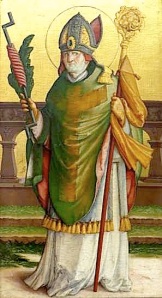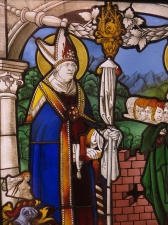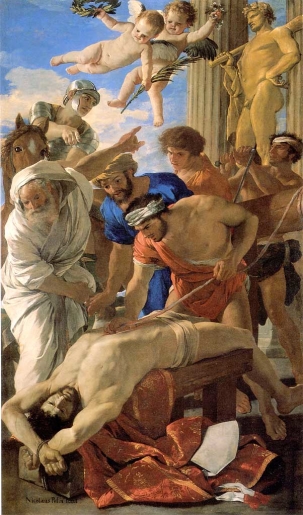Tags
Fourteen Holy Helpers, martyr, Master of Messkirch, Maximian, Saint Elmo, Saint Erasmus, Saint Florian, Saint Stephen, windlass
Saint Erasmus’s primary emblem is the windlass – a crank and shaft used for hoisting or hauling – so it is often assumed that the windlass had something to do with his martyrdom. Martyrs are often portrayed near or actually holding the instruments of their death; for example, Saint Stephen, who was stoned to death, may be shown holding a stone, or Saint Florian, who was drowned after being thrown into a river with a millstone around his neck, may be seen with a millstone. Saint Erasmus’s windlass, however, is emblematic of his patronage of mariners, not his manner of death. Still, the symbol of the windlass (a nautical symbol) and Saint Erasmus’s status as a martyr have become conflated over time, resulting in a gruesome, though erroneous, story of martyrdom by windlass.
Martyrdom of Saint Erasmus
 Saint Erasmus was Bishop of Formiae, Campagna, Italy. The Roman Martyrology recounts that Saint Erasmus “was first scourged with leaded whips and then severely beaten with rods; he had also rosin, brimstone, lead, pitch, wax, and oil poured over him, without receiving any injury.”[1] Later, during the reign of Maximian, “he was again subjected to various most horrible tortures at Mola, but was still preserved from death by the power of God for the strengthening of others in the faith. Finally, celebrated for his sufferings, and called by God, he closed his life by a peaceful and holy end. His body was afterwards transferred to Gaeta.”[2]
Saint Erasmus was Bishop of Formiae, Campagna, Italy. The Roman Martyrology recounts that Saint Erasmus “was first scourged with leaded whips and then severely beaten with rods; he had also rosin, brimstone, lead, pitch, wax, and oil poured over him, without receiving any injury.”[1] Later, during the reign of Maximian, “he was again subjected to various most horrible tortures at Mola, but was still preserved from death by the power of God for the strengthening of others in the faith. Finally, celebrated for his sufferings, and called by God, he closed his life by a peaceful and holy end. His body was afterwards transferred to Gaeta.”[2]
Notably absent from the Roman Martyrology’s account is any mention of a windlass or a dramatic death. On the contrary, the martyrology states that Saint Erasmus died “by a peaceful and holy end.”[3] Over the centuries, however, Saint Erasmus’s frequent portrayal with a windlass and his status as a martyr gave rise to the myth that he had been killed with the use of a windlass. More specifically, and as portrayed to grisly effect in art, a tradition arose that he was disemboweled and that his intestines were wound around a windlass as he was killed.[4]
As Patron Saint of Sailors
 As mentioned, the windlass became a symbol of Saint Erasmus because of his patronage of sailors. During storms at sea, sailors sometimes encountered blue glowing balls of light or blue flames springing from the mastheads of their ships. Because these lights often appeared toward the end of a storm, sailors considered the lights a good omen and a sign of protection from their patron saint.[5] The name “Erasmus” had several variants around the Mediterranean, including “Elmo,” and the lights became known as “St. Elmo’s Fire” or “St. Elmo’s Lights.”[6] St. Elmo’s Fire is a meteorological phenomenon caused by ionization of the air around certain objects, like ships’ masts. Nitrogen and oxygen in the atmosphere fluoresce, like gas in a neon light, with a blue or violet glow, giving St. Elmo’s Fire its distinctive hue.[7]
As mentioned, the windlass became a symbol of Saint Erasmus because of his patronage of sailors. During storms at sea, sailors sometimes encountered blue glowing balls of light or blue flames springing from the mastheads of their ships. Because these lights often appeared toward the end of a storm, sailors considered the lights a good omen and a sign of protection from their patron saint.[5] The name “Erasmus” had several variants around the Mediterranean, including “Elmo,” and the lights became known as “St. Elmo’s Fire” or “St. Elmo’s Lights.”[6] St. Elmo’s Fire is a meteorological phenomenon caused by ionization of the air around certain objects, like ships’ masts. Nitrogen and oxygen in the atmosphere fluoresce, like gas in a neon light, with a blue or violet glow, giving St. Elmo’s Fire its distinctive hue.[7]
Disembowelment By Windlass
Over time, however, Saint Erasmus’s nautical emblem began to take on a more sinister pall. As Rosa Giorgi states in Saints In Art, even though no written evidence held that Saint Erasmus’s intestines were “pulled from his body with a windlass,” the windlass nevertheless “became popularly imagined as an instrument of torture, and thus the atrocious punishment of having one’s intestines extracted with the device was invented.”[8] Giorgi further explains, “This is one example where imagery influenced hagiography.”[9]
As Portrayed in Art
Nicholas Poussin’s The Martyrdom of Saint Erasmus (1628) (pictured at the beginning of this post) perpetuates the myth that Saint Erasmus was disemboweled. The painting is fraught with tension and high drama as Saint Erasmus, his face pained but resolute, is methodically disemboweled while a crowd of his tormentors looks on. Saint Erasmus, who is tied down on his back over a sturdy wooden bench, anchors the scene. His red chasuble and miter, indicating his status as a bishop, are strewn on the ground beside him. His executioner, whose head is positioned near the very center of the painting, leans over him, pulling his intestines from his body. A man in the background to the right of the painting pulls a windlass, winding the intestines around a wooden post.
To the left of the painting, a man in white stares angrily into Saint Erasmus’s face and gesticulates towards a pagan statute crowned with laurel leaves.[10] The man is demanding that Saint Erasmus forsake his faith. Two angels hover above, carrying a laurel wreath and a palm frond, which were symbols of victory to the Romans.[11] Christian artists later appropriated those symbols, particularly the palm frond, and used them to represent a martyr’s victory over death. In The Martyrdom of Saint Erasmus, the angels wait to bestow the crown and palm frond of martyrdom on Saint Erasmus in his final hour.
Other Associations
In addition to being the patron saint of sailors, Saint Erasmus is also the patron saint of a host of other groups, including explosives workers, ordnance workers, and women in labor. He is also invoked against colic, birth pains, intestinal disorders, stomach diseases, and storms. He is one of the Fourteen Holy Helpers, a group of saints regarded as special protectors against various illnesses.
[1] Catholic Church, The Roman Martyrology 161 (revised ed., reprint 1916).
[2] Id. Other sources are more specific about the circumstances of his life and death, although much confusion remains over the particulars of Saint Erasmus’s identity. The Book of the Saints, for example, lists two Saints Eramsus, both from Syria, whose feast days are celebrated on June 2nd and November 25th. Of the second Saint Erasmus, the Book of the Saints concedes, “He may possibly be one and the same with the fourth century Martyr, Erasmus of June 2,” although enough evidence exists to indicate the two were distinct individuals. Benedictine Monks of St. Augustine’s Abbey, The Book of the Saints 95 (photo. reprint 2003) (1921). Still, details of the story of Saint Erasmus, Bishop of Formiae, “point to a confusion between him and some other Martyr of the same name.” Id. Butler’s Lives of the Saints describes additional details of the saint’s life, although it notes with skepticism that “[n]othing is actually known of his history, his so-called ‘acts’ being late compilations based on legends which confuse him with a namesake, a martyr bishop of Antioch.” 2 Butler’s Lives of the Saints 453, 453-454 (Herbert J. Thurston, S.J. & Donald Attwater eds., 2d ed. 1956). Butler’s Lives of the Saints, citing the Acta Sanctorum, does identify the Saint Erasmus at issue here as the Bishop of Formiae and relates that his relics were kept in Campagna in the 6th century. Id. According to Saint Gregory the Great, his relics were translated to Gaeta in 842 when Formiae was destroyed by the Saracens. Id. Saint Erasmus is also sometimes confused with Saint Agapitus of Praeneste. Id. (citing B. de Gaiffner, Etudes d’Histoire et d’Archeologie Namuroises (1949)).
[3] I am not sure how this qualifies as a martyr’s death, but the Roman Martyrology unequivocally describes him as “bishop and martyr.” Id.
[4] Butler’s Lives of the Saints states emphatically, “There is nothing in the legendary history of St Erasmus of Formiae to connect him with that particular form of torture.” Butler’s Lives of the Saints, supra note 2, at 454.
[5] See, e.g., William Beaty and Steven A. Ackerman, “What Causes the Strange Glow Known as St. Elmo’s Fire? Is This Phenomenon Related to Ball Lightning?” Scientific American, Sep. 22, 1997, available at http://www.scientificamerican.com/article.cfm?id=quotwhat-causes-the-stran.
[6] Butler’s Lives of the Saints, supra note 2, at 454.
[7] See Beaty, supra note 5.
[8] Rosa Giorgi, Saints in Art 119 (Stefano Zuffi ed. & Thomas Michael Hartmann trans., 2002).
[9] Id.
[10] I suspect the statue may be of Hercules. Hercules was often portrayed with a wooden club and the skin of the Nemean Lion, which he killed as part of his first labor, draped over an arm or over his shoulders. The figure in Poussin’s painting appears to be carrying a club, which he rests on his right shoulder like a baseball bat, and has something (a lion skin?) draped over his arm.
[11] See George Ferguson, Signs and Symbols in Christian Art 18-19 (1959).



Pingback: ExecutedToday.com » Feast Day of St. Erasmus (St. Elmo)
Pingback: Saint Roch: “The Saint Par Excellence Against Disease” | Reliquarian
Pingback: St. Elmo’s Fire!